Do you want to be a sought-after resource in your niche?
Do you need tips on how to become a Twitter influencer?
To be a leader on Twitter, it's important to understand the dynamics of Twitter conversations and the role of influencers.
In this article I'll show you the two most important types of Twitter influencers and how you can become one.
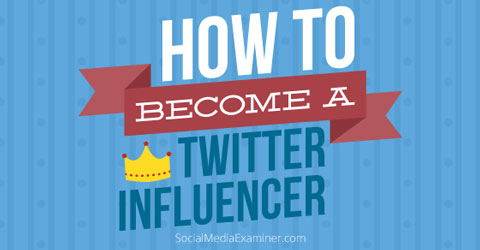
Study and Map Twitter Conversations
Recently, the Pew Research Group and the Social Media Research Foundation conducted an in-depth study of Twitter conversations. They examined thousands of conversations, including the roles of hashtags, retweets, follows, mentions and specific words. They then created maps of multiple subjects to discern patterns and structures.
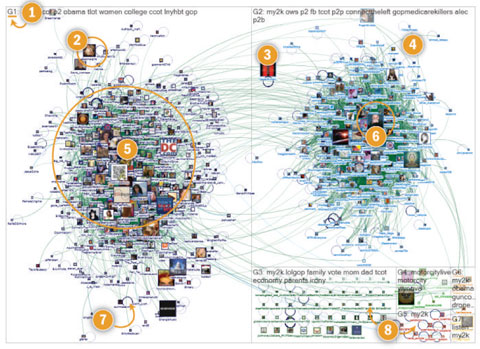
What they found was a “a taxonomy of six distinct types of conversations” each a different size, with varying levels of interconnectivity and an array of discussion subjects.
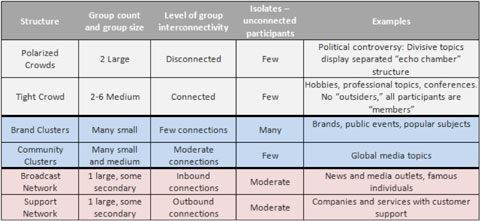
Additionally, the study revealed the presence of “influencers” and provided hints as to how an individual becomes one:
This is the part that fascinates and interests me. I realized that if I could uncover the data characteristics of influencers, I could understand how to become one.
Influencers are the glue of Twitter networks, providing tweet fodder and inspiring passion among followers. Conversations don't exist without them, and their position within networks is a critical component of their influence.
The more capably you navigate the Twitter social sphere, the more influential you become. Based on the Twitter study, there are two types of Twitter influencers—hubs and bridges.
Become a Hub Influencer
The most powerful type of influencer is known as a hub. They are, according to Pew, “[k]ey people who are at the center of their conversational networks.”
Hub influencers create virality by starting movements, creating hashtags and populating the trending board. In many cases, a hub is an influential individual or a media organization.
As the center of a conversational network, a hub influencer tweets new information to a large network of followers, and those followers retweet that information.
Get World-Class Marketing Training — All Year Long!
Are you facing doubt, uncertainty, or overwhelm? The Social Media Marketing Society can help.
Each month, you’ll receive training from trusted marketing experts, covering everything from AI to organic social marketing. When you join, you’ll also get immediate access to:
- A library of 100+ marketing trainings
- A community of like-minded marketers
- Monthly online community meetups
- Relevant news and trends updates
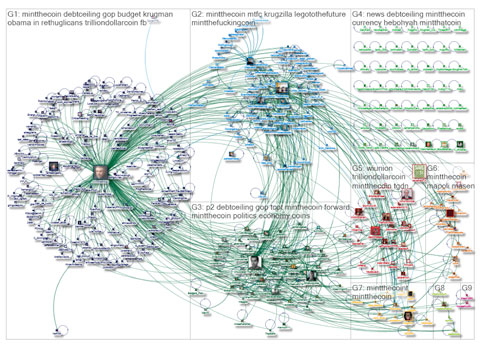
In the example above, Paul Krugman wrote an article discussing a government fiscal issue with political implications and the need to “mint that coin!” The content was original and proposed a massive idea that would revolutionize governmental spending.
Because Krugman is a hub influencer, his article was tweeted by a large number of followers and was inflammatory enough to spawn trending hashtags such as #mintthecoin, #rethuglicans and #krugzilla, among others.

Discover Proven Marketing Strategies and Tips
Want to go even deeper with your marketing? Check out the Social Media Marketing Podcast! Publishing weekly since 2012, the Social Media Marketing Podcast helps you navigate the constantly changing marketing jungle, with expert interviews from marketing pros.
But don’t let the name fool you. This show is about a lot more than just social media marketing. With over 600 episodes and millions of downloads each year, this show has been a trusted source for marketers for well over a decade.
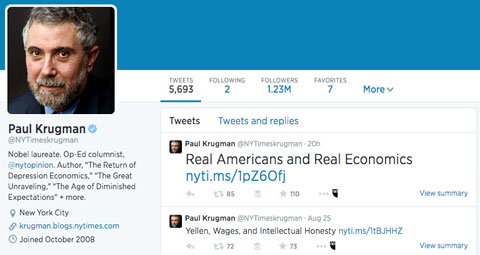
The resulting Twitter discussion fell into two of the conversation types Pew found: Broadcast Network and Polarized Crowds.
Becoming a hub isn't easy. You must produce original information and that information has to be noteworthy enough to warrant retweets. And not only do you have to publish original information, but you also must have enough of the right kind of followers to gain retweets.
You can't be a hub without having a niche. The very word “hub” implies a wheel—a sphere of influence or effect. You need to know your niche, and then become highly familiar with its nuances, vocabulary, hashtags and personalities.
Once you settle into your niche, it's important to form connections. Many hubs have a limited number of people they follow and their influence depends on those who follow them.
If you're just getting started as a hub, you should follow the most significant people in your network. Most importantly, you should connect to “bridges” (discussed in the next section).
Become a Bridge Influencer
While hub influencers create viral movements and hashtags, bridge influencers create virality by sharing relative content and connecting related groups.
Pew defines bridge influencers as playing “the important role of passing information from one group to another.” Bridge influencers may not produce information, but they publicize it.
Their influence depends on their position. Bridges stand between two or more groups, connecting the thoughts and ideas of one group to another. They identify relevant points among groups, and serve as a channel for that information. That sharing is often identified as the point at which a message goes viral.
In the example below, there was one group that originally discussed #mla13 (indicated by the number 1). A bridge was responsible for bringing that hashtag virality to another group (number 2).
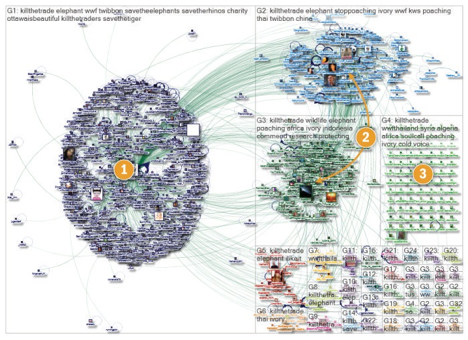
To become a bridge influencer, position yourself solidly by connecting to the sources of primary information (hubs) in your niche, as well as those in niches that have an effect on your primary niche.
For example, let's say a hub such as Search Engine Journal (SEJ) publishes an article on “Conversion Optimization and SEO.” The followers of SEJ are primarily in the SEO niche. However, there is another niche comprised of conversion rate optimization (CRO) experts.
Members of the latter niche may not follow SEJ, but the article is relevant to their industry. This is where you, as a bridge, bring the SEJ article to the attention of the CRO community—connecting the SEO hub and the CRO community.
To be a successful bridge influencer, it's imperative to understand the conversational structure in which you exist. If you're situated within a Polarized Crowd (defined by the Pew research study), you need to understand that these people do not talk much to other groups:
As a bridge, you can serve as the link between the polarized network and outside conversations.
Finally, you'll need to discern what type of information is going to serve your niche. If you go too far off topic, you'll become irrelevant or ignored by your niche. You need to sustain a balance of niche-relevant tweets and bridge tweets.
Conclusion
There is nothing easy about becoming a Twitter influencer. It requires intention and strategy. But once you position yourself as a hub or bridge, you'll be far more adept at shaping your niche and leading others.
What do you think? Are you a hub or a bridge influencer? What content is most popular with your followers and groups? Leave your comments below.
Attention Agency Owners, Brand Marketers, and Consultants

Introducing the Marketing Agency Show–our newest podcast designed to explore the struggles of agency marketers.
Join show host and agency owner, Brooke Sellas, as she interviews agency marketers and digs deep into their biggest challenges. Explore topics like navigating rough economic times, leveraging AI, service diversification, client acquisition, and much more.
Just pull up your favorite podcast app, search for Marketing Agency Show and start listening. Or click the button below for more information.


